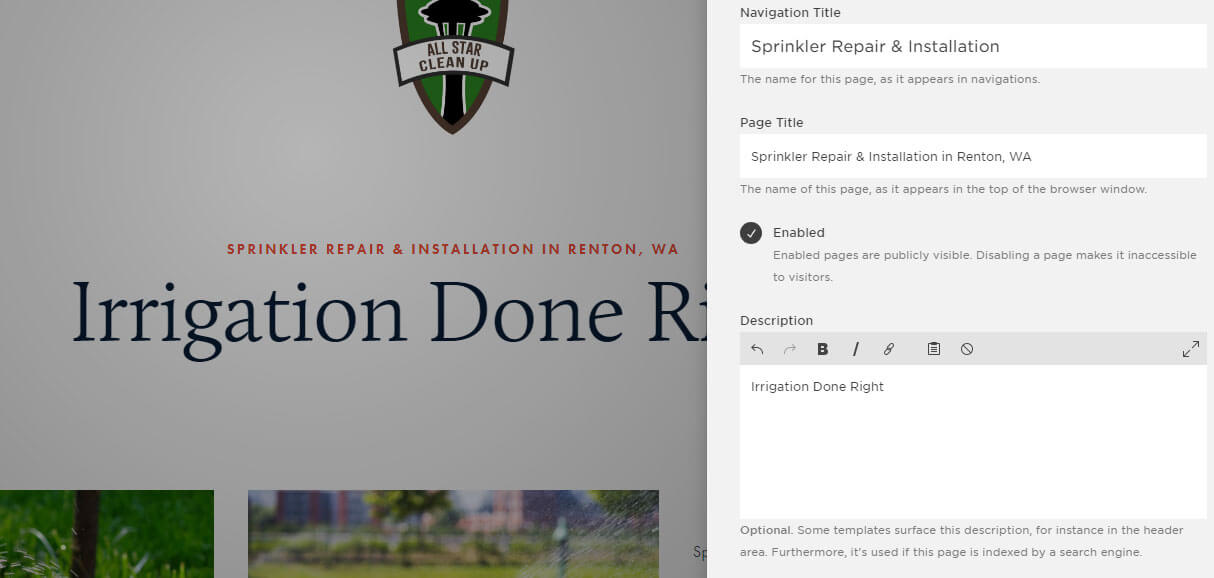In 2018, Squarespace and WordPress are still two of the biggest platforms for building a website, and for good reason.
If you give a bunch of regular users one day to build their first website on any platform, Squarespace’s sites will win by a mile. Godaddy’s site builder, Wix, Drupal, Joomla, and even WordPress can’t compare to Squarespace’s ease of use and extremely high quality templates.
WordPress, on the other hand, might throw new users for a loop—at least at first. In time you’ll come to discover that WordPress is insanely flexible. It just takes a couple of plugins to turn your site into an online store, social network, or so much more.
But which one wins when it comes to SEO? In the battle of Squarespace vs. WordPress SEO, at least in 2018, there is no clear winner. Both platforms have their unique strengths and drawbacks, and it ultimately comes down to your own unique goals.
Don’t worry—you’ll see what I mean soon. Let’s start by taking a look at the areas where WordPress SEO dominates.
Before We Get Started
This post might get a little technical at times. If you get lost, check out these other posts on how SEO works and how to learn SEO.
Where WordPress SEO Beats Squarespace SEO
Page-Level SEO
A lot of SEO happens at the page level, and this is where WordPress shines.
Editing your title tag, meta description, and image alt tags in WordPress is easy—as long as you install a good plugin like Yoast SEO. Their interface is intuitive, their recommended length for each tag is roughly correct, and their global settings are surprisingly powerful. Here’s what that looks like in Green Mountain Turf’s settings:

On the other hand, Squarespace’s on page options are, frankly, pretty terrible. Many of their critical tags are tied to the page layout in annoying ways, and they change from theme to theme. On Harris, for example, the page’s title and meta description are automatically displayed as a heading on screen:

But what if you want a description that sums up the page or highlights a unique selling point that isn’t unique to that specific page, but isn’t repeated on page verbatim? Well, you might be a slightly more sophisticated SEO practitione—and you’d also be out of luck. Bummer.
International SEO
I’m sorry to say I learned this one the hard way.
If you want to translate your WordPress site to another language, you have a lot of options. There are plugins that will let you translate the entire site with Google Translate, there are plugins that will let you translate the entire site manually page-by-page, and there are even plugins that will let you translate the menu options. Like most things WordPress, your options are complicated, plentiful, and powerful.
Squarespace, on the other hand, only offers a few themes that let you create multilinguial sites. Setting one up is janky at best, and in many cases you’ll be stuck using Google Translate.
It also doesn’t always let you edit HTML tags, such as adding translate=”no” to a title section, which would prevent Google Translate from affecting specific text. That means if your name is Sarah Vienna and your site needs to be accessible for German users, there’s no way to stop them from changing your name to Sarah Wiener. True story.
DIY SEO
When it comes to DIY SEO, without the help of an SEO specialist, WordPress has the edge here—or rather, WordPress has the edge if you install the free Yoast SEO plugin.
With it installed, you’re given a fairly in-depth SEO keyword optimization checklist for each page. In English, just pick your keyword and Yoast will tell you what to do with it:

It’s not perfect, but if you follow it to a T you should be in good shape. Squarespace doesn’t have anything like this, which is a shame.
Collaboration
If you’re blogging regularly (which is usually a good idea for SEO), you might want to have someone else help you out.
In Squarespace’s basic $12/month package, you can give access to exactly two other collaborators. That’s two collaborator who can blog, help out with your design, and help interpret your analytics. If you want more, you’ll have to pay more.
In WordPress, there are no limits on how many editors, authors, and other admins you can add. You can even create new user levels to grant or deny access to specific features.
When it comes to collaboration, WordPress wins by a landslide.
Sharing options
Have you ever shared a blog post on social media that pulled in a photo you didn’t see in the original post? In WordPress, that’s extremely easy to set up. The free Yoast lets you set up different titles, images, and descriptions for Facebook and Twitter sharing, and the paid Yoast gives you even more options.
You can also find WordPress plugins to add sharing buttons in a hundred different styles with a hundred different behaviors. If you want giant pinterest buttons on mobile but would rather have a sticky bar with 10 different networks on desktop, just give me a half hour, tops.
SquareSpace? Not so much.
For posts you can pick one thumbnail image and specify an excerpt, but good luck setting up a different sized image for a different social network (or one that includes text on the image itself, for Pinterest.) For pages, you don’t get any of those options at all.
At this point, Squarespace’s SEO is taking a beating, so let’s move on for a second to take a look at what Squarespace gets right—and where WordPress SEO drops the ball.
Where Squarespace SEO Beats WordPress SEO
Quick & Dirty SEO
Here’s where things start to get really weird.
While DIY SEO on WordPress is a lot easier, as long as you have the right plugin, it’s easier to accidentally give your site better SEO in Squarespace.
Let me explain.
In Squarespace, you pick a title for each page and it knows what to do with it. Squarespace will make it your h1 and put it in the title bar, just like it should. If you upload an image and give it a caption, Squarespace will make it the alt tag—which is a pretty decent way to handle alt tags.
WordPress isn’t so friendly by default. Alt tags are empty by default, and default page title/menu anchors/h1s are handled differently by different themes.
Therefore, if you don’t know a thing about SEO, it’s much easier to get lucky with SquareSpace.
Indexing, Crawling & Load Speed
This section might throw you for a loop if you’re not too experienced with SEO. Without going into the finer points of crawl budgets, here’s the big takeaway:
Squarespace good. WordPress bad.
When it comes to indexing, crawling and load speed, Squarespace works pretty well out of the box. Squarespace doesn’t generate a bunch of extra URLs full of duplicate content and garbage. Squarespace’s architecture allows for pretty quick crawling, and their servers translate to low time spent downloading a page:

WordPress’s defaults, frankly, aren’t great. By default, each category, tag, and author automatically gets their own indexable archive. That means if you’ve only used “Kit Kat Quesadilla” as a tag on one post, you’ll get another unique URL that serves up the exact same, technically duplicate content.
While the debate rages on about how catastrohpic this is for your SEO, it’s not good, and it will impact your crawl stats.
WordPress, being the feature-heavy platform it is, can also leave you with a pretty slow site. Enjoy configuring CDNs, tweaking caching plugins, and trying to trim your external JS files if you want a reasonable load speed. You can also host WordPress on any PHP server you want, which includes plenty of bad ones.
User Experience
All of Squarespace’s themes are 100% responsive, and all include some pretty decent responsive behavior. That means you can be relatively sure that if your site looks good on desktop it will at least look good on mobile.
WordPress has hundreds upon thousands of themes, and they’re not all quite so friendly. Nowadays most WordPress themes are also responsive, but you’ll probably want to pick up a premium ($40+) theme if you want a real page builder. Otherwise you’ll just be stuck with one big column of text.
Even then, it can require hours of tweaking your layout settings if you want your site to look good on any screen size. That large, Apple-style product page can easily turn into a whole lot of dead space when you check it out on an iPhone.
Squarespace, generally, doesn’t have that problem. They give you fewer layout options and keep you from getting too creative with them but they all pretty much work.
The Verdict
When it comes to Squarespace vs WordPress SEO, there isn’t a clear winner for everyone, but there is a winner for you.
Squarespace’s default options win when it comes to almost everything. If you know next to nothing about SEO and don’t want to teach yourself SEO, Squarespace’s on-page defaults, crawling and indexing settings, page builder, and high-quality hosting will all make your SEO better without even trying. The downside is that heavy social media promoters and your run-of-the-mill control freaks will be frustrated by just how many options they leave out.
With WordPress, the sky is the limit. The hard part is that it doesn’t tell you when you’re acting like Icarus.
WordPress gives you the power to adjust almost any SEO setting you can think of, through one plugin or another. If you’re obsessed with perfecting your clickthrough rates, on page conversions, or social media strategy, you’ll get along well with WordPress’s SEO.
Of course, there are plenty of things they’re both great at too. Their blogging interfaces are both pretty great, their menu management isn’t bad, and their admin interfaces are pretty well thought out (once you get used to them.) They also both automatically handle some of that Open Graph and Twitter Card data that you don’t want to code by hand, and they both let you use Google Search Console and Google Analytics with their sites—which you absolutely should.
In the end, neither platform will handle 100% of your SEO needs because on-site factors are just a fraction of a real SEO campaign. Ultimately you’ll need to make your own connections, build your own links, and write your own content if you want to beat the competition.





